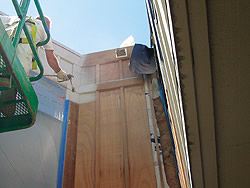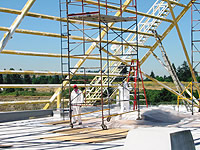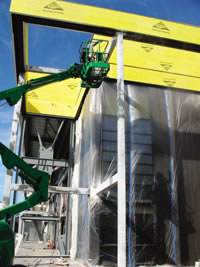
...continued from previous page
Siegner and Company,
Portland, Oregon
Roughly 90 percent of Siegner and Company's business comes from commercial painting, mostly new construction and tenant improvements, from churches and hospitals to office buildings.
by John Strieder
the Flat Iron Building, an early-1900s triangular structure in central Portland that was converted into a wine bar, and a contract to do all the work for McMenamins, a regional chain of brewpubs with more than 40 locations in Oregon and Washington.
Siegner, 54, studied broadcast journalism in college with an eye on a career in radio. But with a family coming on and no high-paying jobs on the horizon, he turned to his uncle, a facilities manager at a building in downtown Portland, for advice.

The man told young Dave to learn a trade. Painting would pay the bills more effectively than journalism, he was told. So Siegner gave up his radio dreams — and a not-very-promising career as a rock guitarist. “You know when you're young you make a choice,” he said. “You think it's going to be a temporary career stop and you end up stuck with it.”
He does not regret his decision. “Painting is a great field, it's just great,” he said. “They might not like you there, but they like what you leave.” Siegner started his career as a union apprentice painter in 1972. He was journeyman, foreman, general superintendent, sales representative and operations manager. Finally, his own firm, Siegner and Company, was incorporated in May 1991. “I wanted to do things the way they should be done,” he said. “I use the golden rule with people.”
 The outfit grew quickly, at a rate of 150 percent every year for the first five years. Today, Siegner and Company employs anywhere between 35 and 50 people on average. The head count had reached 100 before the Sept. 11 tragedy helped deflate the economy. The outfit grew quickly, at a rate of 150 percent every year for the first five years. Today, Siegner and Company employs anywhere between 35 and 50 people on average. The head count had reached 100 before the Sept. 11 tragedy helped deflate the economy.
Siegner sold the company to his two children in 2002. Since then, he has immersed himself in his work with the PDCA.
The most important issue facing the painting industry, he said, is the economy. When times are tough, he said, work that is more material- and labor-intensive tends to get specified out of jobs.
 Another problem for painters these days is maintaining a quality trained work force when other construction and craft trades offer better pay, he said. Wages haven't increased much since he was a foreman, and that can make it tough for painters to attract and retain people who, like him, get into the trade to make money. And the spiraling cost of health insurance further burdens paint contractors who want to present prospective workers with an attractive benefits package. Another problem for painters these days is maintaining a quality trained work force when other construction and craft trades offer better pay, he said. Wages haven't increased much since he was a foreman, and that can make it tough for painters to attract and retain people who, like him, get into the trade to make money. And the spiraling cost of health insurance further burdens paint contractors who want to present prospective workers with an attractive benefits package.
One constraint he supports is OSHA regulations and other safety requirements. “We're very big on safety here,” he said. “We're very receptive to positive changes on the OSHA side.”
Indeed, the firm has won several national safety achievement awards from the PDCA. “Siegner and Company, for its size, is one of the safest painting contractors in Oregon and Southwest Washington,” boasts the company's brochure.
For more information, visit the Siegner and Company Web site or call (503) 735-3001.

|

